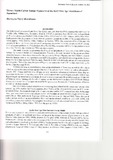Dietary stable carbon isotope signatures of the Early Iron Age inhabitants of Ngamiland
Date
2011Author
Mosothwane, Morongwa N.
Publisher
Botswana Society, http://www.botsoc.org.bwType
Published ArticleMetadata
Show full item recordAbstract
The wide spread presence of Late Stone Age (LSA) and Early Iron Age (EIA) communities such as at the Tsodilo Hills, Matlapaneng, Serondela, Qogana, and other sites have been documented in Ngamiland, nofthwestetn Botswana (Denbow 1980, 1986a, 1986b, 1999; Campbell 1982; Wilmsen & Denbow 2005). Radiocarbon dates from many of these sites are generally around the middle of the second millennium AD (Campbell 1982; Denbow 1986b;Wilmsen & Denbow 2005). The sequences of both LSA and EIA settlements show that the area was occupied continuously for several centuries. As early as the 6th century AD LSA hunter-gatherers and EIA fatmers of the Tsodilo Hills co-existed within a few kilometres of each other (see Denbow, this volume and Wilmsen, this volume).
This study attempts to reconstruct the diets of the inhabitants of these sites using stable carbon isotope signatures of human and animal remains. Therefore, the sites included in this reporl are those where human graves have been excavated in the past mainly Divuyr, Nqoma, and Xaro. Reports indicate that other human remains may have been excavated in the past but their whereabouts are unknown. As such those sites have been excluded from this study. There three sites included in the site are all associated with the ElA period. Two of the sites, Dimyu and Nqoma, are both in the Tsodilo Hills while Xaro is along the banks of the Okavango River.

